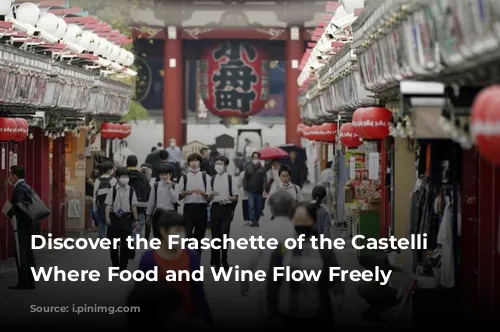Imagine a world where dining is a leisurely journey through ancient history, vibrant culture, and breathtaking landscapes. Welcome to the Castelli Romani, a collection of 17 charming towns nestled amidst volcanic hills just southeast of Rome. This enchanting region is renowned for its fraschette, traditional maker-run wine bars that embody the true spirit of Italian hospitality.
A Journey Through Time: From Medieval Origins to Modern Delights
The fraschetta tradition dates back to medieval times, when winemakers would hang a laurel branch (frasca) outside their cellars to signal the arrival of fresh wine. Locals and travelers alike would gather to celebrate, bringing their own snacks and savories to pair with the freshly fermented nectar. This simple act of sharing transformed into a vibrant custom, fostering a strong sense of community and celebrating the rich heritage of the Castelli Romani.
Today, the fraschette remain a vital part of local life. While many now offer a selection of dishes, the core essence persists: a welcoming ambiance, locally-sourced wine, and a focus on simple, delicious fare.

Frascati: The Heart of the Fraschetta Experience
Frascati, the liveliest of the Castelli Romani towns, serves as a perfect gateway to the world of fraschette. Our journey begins in its historic center, where we visit a local butcher for cured meats, a deli for olives and panzanella, and a bakery for freshly baked sourdough. This is a quintessential Italian experience, immersing us in the vibrant flavors and traditions of the region.
Indulging in the Art of “La Dolce Vita”
As we settle into our impromptu picnic outside Osteria dell’Olmo, the air buzzes with the sounds of laughter and chatter. The owner, Remigio Sognatesori, greets us with a warm smile, a testament to the welcoming nature of fraschette. We sip on chilled white wine, our senses captivated by the captivating panorama that stretches before us.
Exploring the Castelli Romani: More Than Just Food and Wine
Beyond the allure of delectable cuisine and flowing wine, the Castelli Romani offers a glimpse into a world of historical treasures and natural wonders. From the ancient Roman ruins of Albano to the charming hilltop village of Lanuvio, each town holds its own captivating story.
Ancient History Meets Modern Charm
Albano, nestled along the historic Appian Way, boasts a wealth of Roman heritage. We stand in awe of its second-century military gateway, explore the vast Roman water cisterns, and marvel at the acoustics of its well-preserved amphitheater.
Lanuvio, a small but captivating town, offers a captivating blend of ancient and modern. A seventh-century BC temple to Juno stands proudly on a green hill, sharing space with a dog park and children’s playground. The water fountain in its town square, a richly carved second-century Roman sarcophagus, speaks to the town’s rich history and its embrace of the present.
Villas of the Renaissance: Opulence and History
The Castelli Romani were once a favored retreat for Roman nobles, including Cicero. In the Renaissance, wealthy families built opulent summer villas, many of which are now open to the public. These magnificent structures, adorned with intricate details and luxurious furnishings, offer a glimpse into the grandeur of the past.
A Culinary Journey: Porchetta and More
The Castelli Romani boasts a wealth of culinary delights, each reflecting the region’s agricultural bounty and culinary heritage. Ariccia, a charming town just a short walk from Albano station, is renowned for its porchetta, a succulent boneless roast pig that embodies the essence of Italian comfort food.
Fraschette throughout the region offer unique takes on this local delicacy, each with its own special charm. In Ariccia, we sample a delectable antipasto at Sora Ines, a feast for the senses that includes mounds of porchetta with crispy crackling, prosciutto, mozzarella, melon, mushrooms, roasted aubergines, and more.
Fraschette and Their Culinary Innovations
The fraschette of the Castelli Romani are more than just places to enjoy traditional fare. They are also havens of culinary creativity, where local chefs are pushing the boundaries of Italian gastronomy.
We visit Osteria di Corte in Ariccia, where young chef Marco Liberti’s cacio e pepe pasta has earned him recognition on the popular TV food show, 4 Ristoranti. The dish, a creamy masterpiece of sheep’s cheese coating fat spaghetti with a touch of black pepper, is a testament to the innovative spirit that defines modern fraschetta cuisine.
A Taste of the Castelli Romani: Wine, Food, and Culture
Our journey through the Castelli Romani is not just a culinary adventure, but a cultural immersion. We experience the warmth of local hospitality, savor the exquisite flavors of regional cuisine, and delve into the rich history and heritage of these enchanting towns. We sip on Marco Fabi’s delicious straw-colored whites in a wine museum he has set up in a disused cellar in Marino, a village whose fountain runs with wine during festival time.
We discover Fòr de Porta, a fraschetta in Marino village center that offers a delectable selection of vegan options, including truffles, bean purees, fennel, and wild mushrooms. This variety showcases the adaptability and inclusivity of the fraschetta experience.
A Symphony of Nature: Lakes, Trails, and Tranquility
The Castelli Romani are more than just charming towns; they are also a haven of natural beauty. Two deep, greeny-blue lakes, Albano and Nemi, offer breathtaking views and a serene escape from the bustling city. The larger lake, Albano, boasts beaches on one side, perfect for kayaking and paddleboarding. Its wilder eastern side, however, is ideal for cycling or hiking along scenic trails.
The towering Monte Cavo, at almost 1,000 meters, beckons adventurous souls with its breathtaking panoramic views. The Castelli Romani offer a unique blend of history, culture, and natural beauty, creating an unforgettable experience for all who visit.
